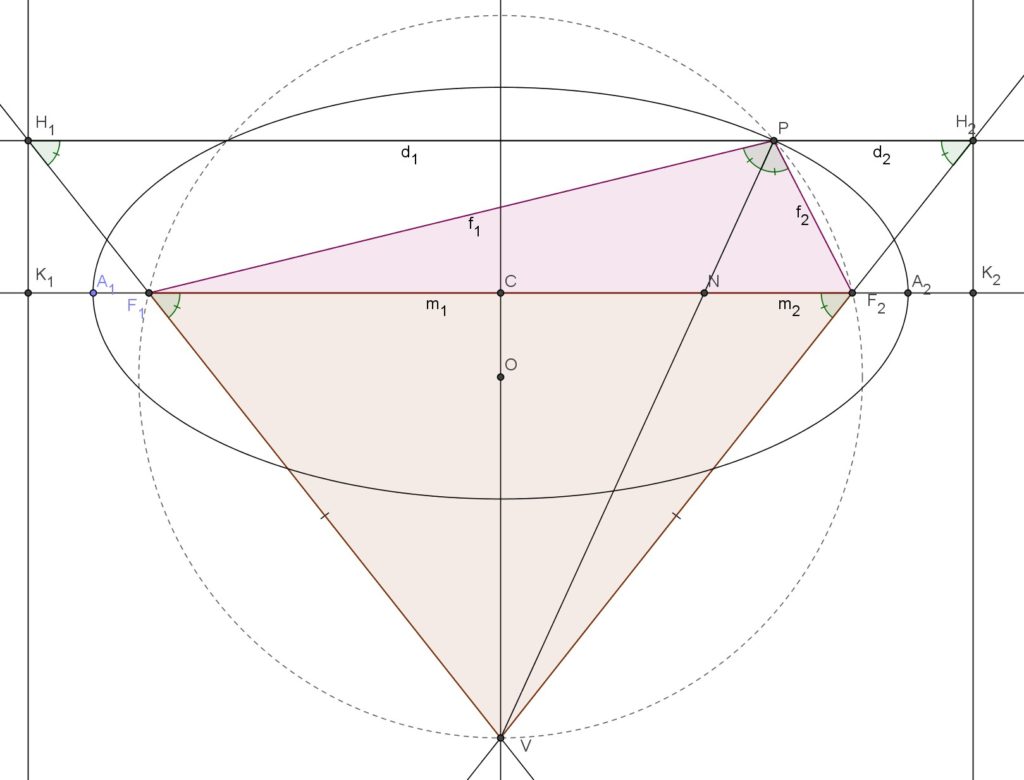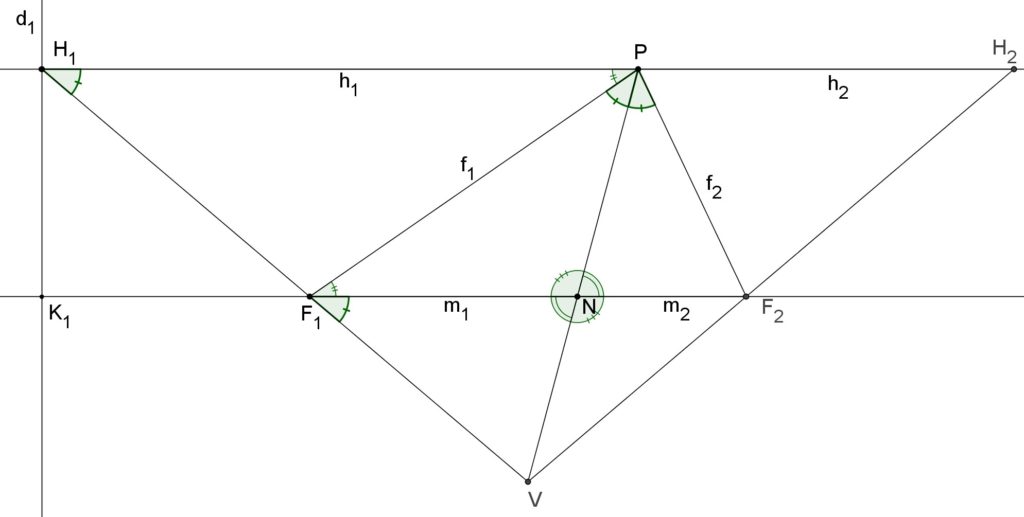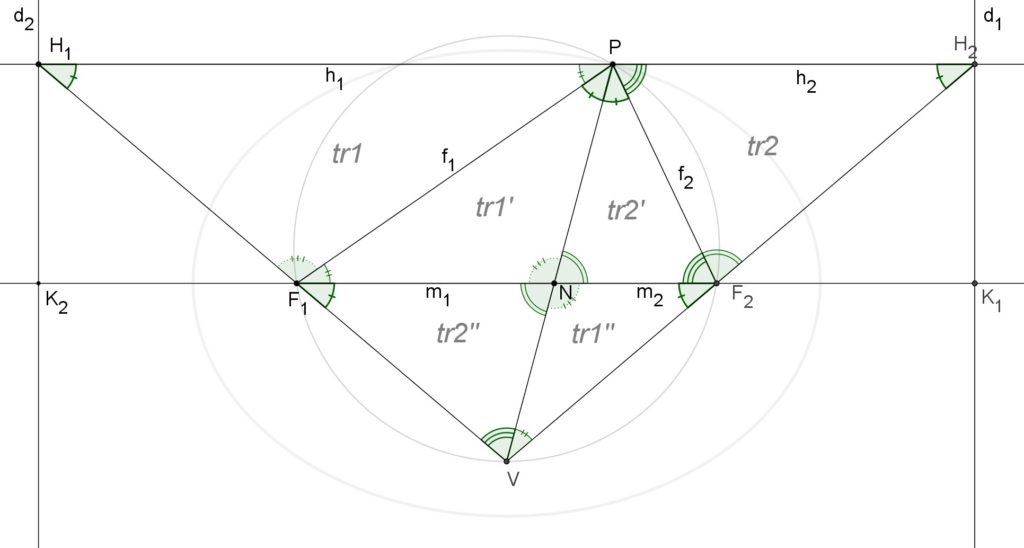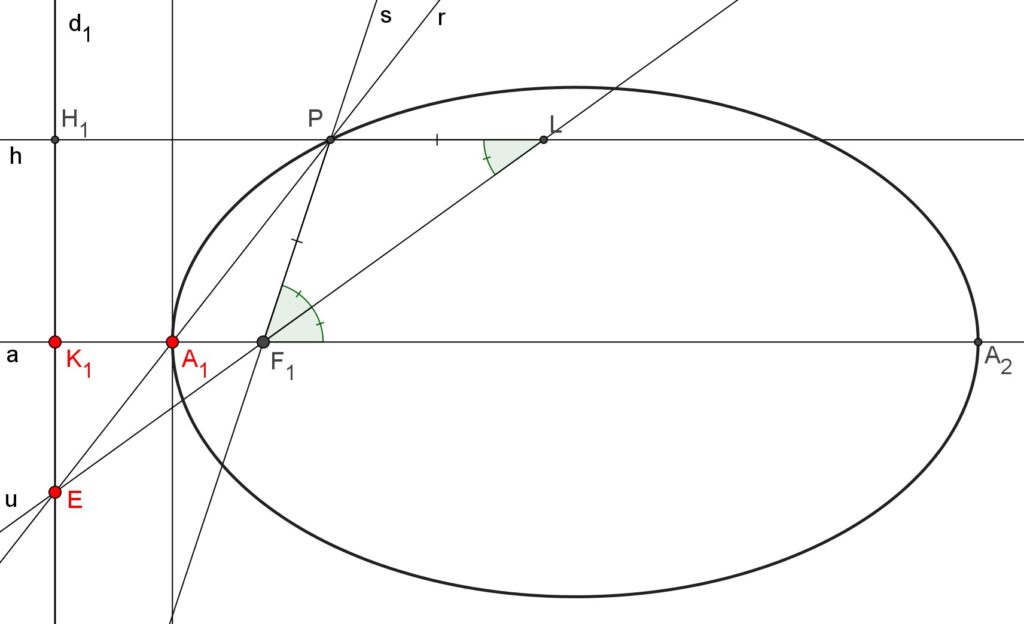Every time I try to get some deeper insight about Newton’s gravitational law I stumble upon the geometrical properties of the ellipse.
After many years of these strange and challenging encounters I really think that the ellipse is a rich and wonderful trove of geometrical nuances and subtleties.
The geometric definition of an ellipse can be given with two alternative but equivalent statements:
A) An ellipse is a plane curve whose points (![]() ) are such that the sum of the distances from
) are such that the sum of the distances from ![]() to two fixed points (the foci,
to two fixed points (the foci, ![]() and
and ![]() ) is constant. That is
) is constant. That is
![]() (where
(where ![]() is the semi-major axis of the ellipse)
is the semi-major axis of the ellipse)
B) An ellipse is a plane curve whose points (![]() ) are such that the ratio of the distance of
) are such that the ratio of the distance of ![]() from a fixed point (focus)
from a fixed point (focus) ![]() and from a fixed line (directrix)
and from a fixed line (directrix) ![]() is constant. That is, calling
is constant. That is, calling ![]() the perpendicular projection of
the perpendicular projection of ![]() on
on ![]() , it is
, it is
![]() (where
(where ![]() )
)
The equivalence of the two definitions can be elegantly proved in space geometry (3D) with the Dandelin spheres, and using the fact that the ellipse is a conic section.
Another possible road is to use the analytic geometry in a Cartesian frame of reference.
Anyway I have been for a long time looking for a geometric proof of the equivalence of the two definitions using pure plane geometry (in 2D) using the classic procedures of Euclidean geometry.
Since I couldn’t find any proof of this kind in the web, some years ago (in 2008) I tried to devise one by myself.
By pure chance I’ve rediscovered in these days (October 2016) that old demonstration of several years ago and I’ve found it quite interesting and potentially rich of clues for other possible geometric investigations, although in need of some refinement.
So, here is a possible (and tentative) pure geometric demonstration using plain plane geometry showing the equivalence of the two definitions of the ellipse.
It is essentially unchanged with respect to the old version, but I have added a few more details to smooth out some passages.
I’m fully aware this demonstration is much more complex than the one with the Dandelin spheres, and that it could be improved and maybe made simpler, but it temporarily meets my needs for a proof living in plane (2D) geometry (until I find something better than this).
The first part I) is aimed to prove that definition A) implies definition B) while the second part II) (just sketched as it is mostly a reversion of the steps followed in the first part) is aimed to prove that definition B) implies A).
In a third part III) I’ve included a geometric construction of the ellipse, taken from a classic textbook.
I) First part: A)  B)
B)
Given the locus of points for which is constant the sum of the distances from two fixed points ![]() and
and ![]() then for any point
then for any point ![]() belonging to the locus it is
belonging to the locus it is ![]() , where
, where ![]() is the distance from
is the distance from ![]() and an appropriate fixed line (directrix) perpendicular to the line joining
and an appropriate fixed line (directrix) perpendicular to the line joining ![]() and
and ![]() .
.
Demonstration
Let it be
![]()
First, consider the triangle ![]() , and construct the circumscribed circle around it.
, and construct the circumscribed circle around it.
The perpendicular bisector of the segment ![]() meets the circle (on the arc
meets the circle (on the arc ![]() not including
not including ![]() ) in
) in ![]() . The quadrilateral
. The quadrilateral ![]() is then a cyclic quadrilateral.
is then a cyclic quadrilateral.
Let’s call ![]() the intersection of the line
the intersection of the line ![]() with the line joining
with the line joining ![]() and
and ![]() , and we’ll call
, and we’ll call ![]() and
and ![]() .
.
We also define ![]() and
and ![]() as the points where the line through
as the points where the line through ![]() and parallel to
and parallel to ![]() meets the lines
meets the lines ![]() and
and ![]() respectively. We’ll then call
respectively. We’ll then call ![]()
Since ![]() , it follows, for the chord properties, that the segment
, it follows, for the chord properties, that the segment ![]() bisects the angle
bisects the angle ![]() , so that
, so that ![]()
Applying the angle bisector theorem to the triangle ![]() we have
we have
![]()
It’s also
![]()
and
![]()
The triangles ![]() and
and ![]() are similar (they have the same angle
are similar (they have the same angle ![]() and two alternate interior angles). So, also the triangles
and two alternate interior angles). So, also the triangles ![]() and
and ![]() are similar.
are similar.
Thence it is
![]()
and
![]()
whence
![]()
That is
![]()
To complete the demonstration we must show that the points ![]() and
and ![]() lie on two parallel lines that have a certain constant distance, independently of the choice of the point
lie on two parallel lines that have a certain constant distance, independently of the choice of the point ![]() of the ellipse.
of the ellipse.
These two lines are the two alternative choices for the directrix, at the right or left side of the segment joining the two foci.
First, it can be observed that the line segment ![]() is, by construction, parallel to the focal axis
is, by construction, parallel to the focal axis ![]() and that the two points
and that the two points ![]() and
and ![]() are symmetric with respect to the perpendicular bisector of the segment
are symmetric with respect to the perpendicular bisector of the segment ![]() .
.
Furthermore, the distance ![]() is constant.
is constant.
In fact the proportion ![]() can be rewritten as
can be rewritten as
![]()
and since ![]() ,
, ![]() and
and ![]() we have
we have
![]()
So the distance ![]() doesn’t depend on the choice of the point
doesn’t depend on the choice of the point ![]() on the ellipse and the distance of the directrix line from the vertical axis of the ellipse is
on the ellipse and the distance of the directrix line from the vertical axis of the ellipse is ![]() .
.
This completes the demonstration that ![]() (or
(or ![]() ) and that
) and that ![]() (or
(or ![]() ) is the distance from
) is the distance from ![]() to an appropriate fixed line (directrix) perpendicular to the line joining
to an appropriate fixed line (directrix) perpendicular to the line joining ![]() and
and ![]() as for the initial statement1.
as for the initial statement1.
1 That the directrix is a straight line perpendicular to the focal axis follows from the fact that the second directrix is symmetric to the first with respect of the perpendicular bisector of the segment ![]() and from the fact that the distances
and from the fact that the distances ![]() are constant. Only a straight vertical line satisfies both these conditions.
are constant. Only a straight vertical line satisfies both these conditions.
II) Second part: B)  A)
A)
Given the locus of points for which the ratio between the distances from a fixed point ![]() (focus) and a fixed line (directrix) has a constant value
(focus) and a fixed line (directrix) has a constant value ![]() with
with ![]() , then
, then
II.1) There exists a second focus ![]() and a second directrix
and a second directrix ![]() for which the same relation between the distances from
for which the same relation between the distances from ![]() apply, That is
apply, That is ![]() .
.
II.2) For any point ![]() belonging to the locus the sum of the distances of
belonging to the locus the sum of the distances of ![]() to the foci
to the foci ![]() and
and ![]() has a constant value.
has a constant value.
Demonstration of II.1
Basically, starting from the focus ![]() , the directrix
, the directrix ![]() , a point
, a point ![]() belonging to the locus, and calling
belonging to the locus, and calling ![]() the perpendicular projection of
the perpendicular projection of ![]() on the directrix it’s possible to build the triangle
on the directrix it’s possible to build the triangle ![]() , and the similar triangle
, and the similar triangle ![]() where the side
where the side ![]() is parallel to
is parallel to ![]() and with the angle
and with the angle ![]() congruent to the angle
congruent to the angle ![]() . The lines
. The lines ![]() and
and ![]() meets at a point
meets at a point ![]() . The second focus
. The second focus ![]() , on the line
, on the line ![]() , is such that the line
, is such that the line ![]() bisects the angle
bisects the angle ![]() . The line
. The line ![]() intersects the line
intersects the line ![]() in the point
in the point ![]() that defines the position of the second directrix
that defines the position of the second directrix ![]() (that is the line through
(that is the line through ![]() parallel to
parallel to ![]() ).
).
With this construction we can show that the triangle ![]() is isosceles.
is isosceles.
In fact, the triangles ![]() and
and ![]() are similar (by construction).
are similar (by construction).
The triangles ![]() and
and ![]() are similar, since they have two congruent angles:
are similar, since they have two congruent angles: ![]() (opposite angles) and
(opposite angles) and ![]() (
(![]() ).
).
Then it is ![]() .
.
Also the triangles ![]() and
and ![]() are similar, for the SAS similarity criterion, since they have a congruent angle,
are similar, for the SAS similarity criterion, since they have a congruent angle, ![]() (opposite angles) and the two sides adjacent to that angle have lengths in the same ratio. In fact, as shown above, it is
(opposite angles) and the two sides adjacent to that angle have lengths in the same ratio. In fact, as shown above, it is ![]() (or, equivalently,
(or, equivalently, ![]() ).
).
Then ![]() and this proves the fact that the triangle
and this proves the fact that the triangle ![]() is isosceles.
is isosceles.
Thence ![]() and the point
and the point ![]() belongs to the perpendicular bisector of the segment
belongs to the perpendicular bisector of the segment ![]() .
.
Furthermore it can be easily proved that ![]() and that imply that the quadrilateral
and that imply that the quadrilateral ![]() is a cyclic quadrilateral and that the point
is a cyclic quadrilateral and that the point ![]() belongs to the circumscribed circle of the triangle
belongs to the circumscribed circle of the triangle ![]() .
.
With the construction of the point ![]() we can see that also the triangles
we can see that also the triangles ![]() and
and ![]() are similar (for they have the congruent alternate interior angles
are similar (for they have the congruent alternate interior angles ![]() and the congruent angles
and the congruent angles ![]() ).
).
Here is an updated figure representing the geometric properties found so far, highlighting the similarity of the triangles ![]() , the similarity of the triangles
, the similarity of the triangles ![]() and the congruent angles.
and the congruent angles.
For the angle bisector theorem applied to the triangle ![]() , with the angle in
, with the angle in ![]() bisected in the two congruent angles
bisected in the two congruent angles ![]() and
and ![]() , it is
, it is
(a) ![]()
For the similitude of the triangles ![]() and
and ![]() it is
it is
(b) ![]()
For the similitude of the triangles ![]() and
and ![]() it is
it is
(c) ![]()
Putting together (a) with (b) and (c) it is
![]()
that is
![]()
Demonstration of II.2
Since
![]()
it follows that
![]()
and
![]()
Summing the terms it is
![]()
so that the sum of the distances of ![]() to the foci
to the foci ![]() and
and ![]() has a constant value.
has a constant value.
Q.E.D.
III) A geometric construction of the ellipse using definition B)
To enrich the geometrical investigation of the ellipse from the point of view of the definition B) here is a geometrical construction of the points ![]() of the ellipse.
of the ellipse.
It is based on the classic textbook
W. H. Besant – Conic Sections Treated Geometrically – 1895 – chapter 3 (see the References at the bottom for a link to the free ebook).
I’ve only changed the naming of the points and lines and have given some more detail to some of the passages.
With this construction, starting from a given directrix ![]() and a given focus
and a given focus ![]() and calling
and calling ![]() the perpendicular projection of
the perpendicular projection of ![]() on
on ![]() , each point
, each point ![]() of the ellipse must satisfy the condition
of the ellipse must satisfy the condition
(d) ![]()
where ![]()
Construction
Let ![]() be the focus,
be the focus, ![]() the directrix,
the directrix, ![]() the line through
the line through ![]() perpendicular to
perpendicular to ![]() and
and ![]() the intersection between
the intersection between ![]() and
and ![]() .
.
Divide ![]() at the point
at the point ![]() in the given ratio (
in the given ratio (![]() ).
).
The point ![]() is one point of the ellipse since it complies with the definition (d). In particular it is one of the ellipse vertices.
is one point of the ellipse since it complies with the definition (d). In particular it is one of the ellipse vertices.
Construct another point ![]() on
on ![]() satisfying the proportion
satisfying the proportion ![]() .
.
![]() is another point of the ellipse and another of its vertices.
is another point of the ellipse and another of its vertices.
Choose some point ![]() anywhere on the directrix
anywhere on the directrix ![]() , join it with
, join it with ![]() (line
(line ![]() ) and draw, from
) and draw, from ![]() another line
another line ![]() such that it forms with the line
such that it forms with the line ![]() the same angle as the one that
the same angle as the one that ![]() forms with the horizontal line
forms with the horizontal line ![]() .
.
Join the points ![]() and
and ![]() to form the line
to form the line ![]() and call
and call ![]() the intersection point between the lines
the intersection point between the lines ![]() and
and ![]() .
.
Draw from ![]() a line
a line ![]() parallel to the horizontal line
parallel to the horizontal line ![]() . Call
. Call ![]() its intersection with the directrix
its intersection with the directrix ![]() and
and ![]() its intersection with the line
its intersection with the line ![]() .
.
Since by construction it is ![]() and since
and since ![]() (alternate interior angles) it follows that
(alternate interior angles) it follows that ![]() and the triangle
and the triangle ![]() is isoceles.
is isoceles.
Then it is ![]() .
.
Considering the parallel lines ![]() and
and ![]() , cut by the lines
, cut by the lines ![]() ,
, ![]() and
and ![]() drawn from the common point
drawn from the common point ![]() , for Thales’ intercept theorem it is
, for Thales’ intercept theorem it is
![]()
and putting in the congruence between ![]() and
and ![]() it is also
it is also
![]()
Then the the point ![]() belongs to the locus of points (ellipse) for which it is
belongs to the locus of points (ellipse) for which it is ![]() .
.
Changing the choice of the point ![]() on
on ![]() will result in a different point
will result in a different point ![]() but this will nonetheless belong to the same ellipse.
but this will nonetheless belong to the same ellipse.
References
https://en.wikipedia.org/wiki/Ellipse
https://en.wikipedia.org/wiki/Dandelin_spheres
https://en.wikipedia.org/wiki/Conic_section
https://www.physicsforums.com/threads/ellipse-geometric-equivalence-of-two-definitions.247417/
W. H. Besant – Conic Sections Treated Geometrically (1895) – (free ebook in Project Gutenberg)



